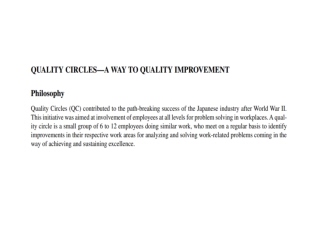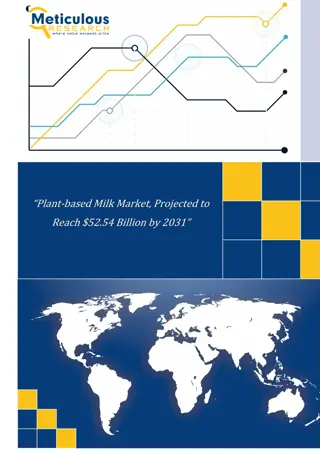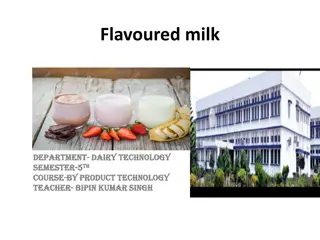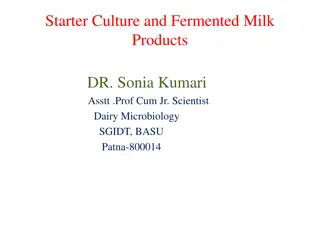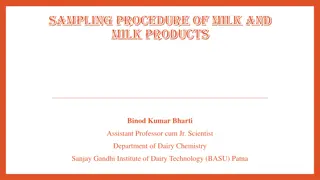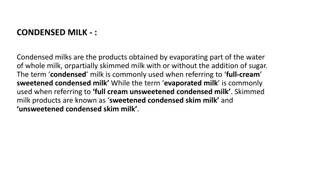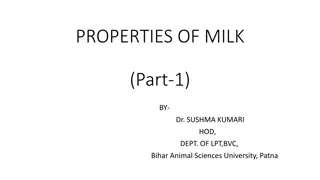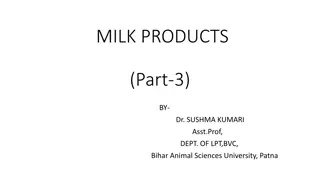Understanding Starter Culture Defects in Fermented Milk Products
Common problems with starter cultures in fermented milk products include insufficient acid and flavor production, as well as various defects like sharp acid taste, malty flavor, metallic flavor, green flavor, flat flavor, and bitterness. Factors contributing to these issues range from milk quality to production processes, leading to potential failure of starter cultures.
Download Presentation

Please find below an Image/Link to download the presentation.
The content on the website is provided AS IS for your information and personal use only. It may not be sold, licensed, or shared on other websites without obtaining consent from the author. Download presentation by click this link. If you encounter any issues during the download, it is possible that the publisher has removed the file from their server.
E N D
Presentation Transcript
Starter Culture and Fermented Milk Products DR. Sonia Kumari Asstt .Prof Cum Jr. Scientist Dairy Microbiology SGIDT, BASU Patna-800014
STARTER DEFECTS: The major problems associated with the starter cultures are: 1. Insufficient acid production 2. Insufficient flavor production. 3. Defects in Flavor. 4. Body and texture defects.
Insufficient acid production or non-acid curd: The reasons for the insufficient acid production could be A) Spontaneous loss of vitality inherent in starter itself: The reason may its strain variation or genetic instability that are usually associated with plasmids, or loss of lac plasmid. B) Uncontrolled production process: The mismanagement may allow contaminants to spoil the starter. frequent sub-culturing may also lead to loss of vitality of the starter. Use of unsuitable media and use of wrong incubation temperatures etc are the another reason to allow other contaminants to grow. C) Inherent factors in milk itself: LP system, Lysozyme, Lactoferin etc that may sometime slow the activity of Starter culture itself. D) Use of Milk of abnormal quality i.e. mastitis milk or colostrums milk or late lactation milk or silage milk or winter milk may slow the growth of starter culture. E) Changes in the method of production of fermented milk:
Another reason for the failure of starter cultures are Milk containing antibiotic residues. Milk contaminated with bacteriophage. Milk containing residues of detergents and sanitizers. Milk having inhibitory bacteria. Seasonal variations in milk composition. Milk containing natural inhibitory substances like leucocytes, antibiotics etc. Excessive aeration of milk
Insufficient flavor production: factors affect the flavor: Improper acid production. Milk having low citrate ions. Milk containing high Gram negative organisms that reduce diacetyl content by Producing diacetyl reductase etc
Defects in Flavor a) Sharp acid taste : Sometime taking high inocula may turn over ripening of the culture. Also keeping the Starter at higher incubation temperature or prolonged incubation period may increase the acidity of the product. b) Malty flavor: Lactococcus lactis ssp. lactis var maltigenes. c) Metallic flavor: over ripening of the culture or use of poorly maintained containers with metallic contamination or over growth of Leuconostoc sp. d) Green flavor: under development of Leuconostocs as result of repeated transfer of culture before adequate development. e) Flat flavor: small amounts of citrates in milk or under development of aroma culture. f) Bitterness: Proteolytic contaminants that breakdown protein and release sulphur compound which cause bitterness in milk
Body and texture defects : a) Weak body : Insufficient acid production or milk with low total solids or milk subjected to severe heat treatment b) Hard and lumpy: It is due to over ripening. c) Wheying off: It is due to over ripening or due to low total solids in milk that result in defect in starters. Use of un-homogenized whole milk, agitation or vibration of culture soon after curd begins to form may create wheying off of curd. Whey may collect on the surface or at the bottom of the culture or beneath the cream layer d) Roppiness : Alcaligenes viscolactis or Leuconostocs or L. lactis ssp lactis var hollandicus . e) Gassiness: Production of CO2by the coli forms or yeast. Certain strain of Leuconostocs may cause floating curd defect in cottage cheese. In cheddar cheese gas production may be undesirable because it results in eye formation or bulging of cans.
Problems with production method: Use of abnormal milk Use of poor quality starter cultures . Use of improperly cleaned utensils and equipment. Use of milk subjected to improper heat treatment. Use of unhygienic production practices. Handling persons with unclean habits and unhealthy persons. Use of improperly cleaned and sterilized packaging material. Use of improper storage conditions and temperatures.


